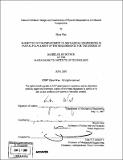Musical interfaces : design and construction of physical manipulatives for musical composition
Author(s)
Wan, Elysa (Elysa Q.)
DownloadFull printable version (1.275Mb)
Other Contributors
Massachusetts Institute of Technology. Dept. of Mechanical Engineering.
Advisor
Hiroshi Ishii.
Terms of use
Metadata
Show full item recordAbstract
Currently, musical composition is considered to be a high-level skill that is inaccessible to young children. There is a "high floor" for children who want to create a piece of music because they must learn a way of recording and remembering the notes, their sequence, etc, such as musical notation. Our project explores tangible designs that will make music composition simple to learn and practice while also building an intuition about complex musical concepts. Three original designs of tangible interfaces for musical composition are introduced and the merits and limitations of each are explored using non-functional form models. Audio processing is performed on a peripheral computer running an audio program written specifically for each system. A "Wizard of Oz" approach was used to study user interactions with each design. Music Blocks are designed to be physical representations of inherently intangible musical notes. Each block represents a single note, and the user can modify its pitch and duration by changing the physical shape of the block. They resemble wooden building blocks and suggest the parallels between building structures and the organization of musical compositions and its melody. The Music Glove introduced the idea of using a sound recording instead of a musical note as the musical unit in a composition. This introduced rich ideas about nesting and recursion. At the same time the glove interface highlights the role of personal expression, interaction and affect in musical composition and performance. Here physical inputs of the system were related to the rhythms, tempos, and the tone of the composition. The system was more gestural, performance-oriented and more suited to spontaneous improvising. The Musical Leaves interface is a melding of the concepts for the Music Blocks and Glove. The individual Leaves reflect the modular structure and organization of the composition. At the same time, the Leaves can be manipulated in real-time to change pitch and volume and as a result are deeply expressive and flexible.
Description
Thesis (S.B.)--Massachusetts Institute of Technology, Dept. of Mechanical Engineering, 2007. Includes bibliographical references (leaf 19).
Date issued
2007Department
Massachusetts Institute of Technology. Department of Mechanical EngineeringPublisher
Massachusetts Institute of Technology
Keywords
Mechanical Engineering.